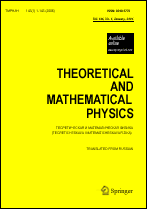|
This article is cited in 20 scientific papers (total in 20 papers)
Schrödinger Uncertainty Relations and Physical Features of Correlated-Coherent States
A. D. Sukhanov
Peoples Friendship University of Russia
Abstract:
We show that the difference between the Schrödinger uncertainty relations (UR) and the Heisenberg UR is fundamental. We propose a modified version of stochastic mechanics that allows clearly demonstrating that the contributions from the anticommutator and the commutator to the Schrödinger UR are equally important. A classification of quantum states minimizing the Schrödinger UR at an arbitrary instant is proposed. We show that the correlation of the coordinate and momentum fluctuations in such correlated-coherent states (CCS) is largely determined by the contributions from not only the commutator but also the anticommutator of the corresponding operators. We demonstrate that the character of this correlation changes qualitatively in time from the antiphase correlation typical for the Heisenberg UR to the inphase correlation for which the contribution from the anticommutator is decisive. We comparatively analyze properties of a free microparticle and a quantum oscillator in CCS and show that the CCS correspond to traveling-standing de Broglie waves in both models.
Keywords:
Schrödinger universal uncertainty relations, generalized correlator, correlated-coherent states, antiphase and inphase correlation of fluctuations.
Received: 20.02.2002
Citation:
A. D. Sukhanov, “Schrödinger Uncertainty Relations and Physical Features of Correlated-Coherent States”, TMF, 132:3 (2002), 449–468; Theoret. and Math. Phys., 132:3 (2002), 1277–1294
Linking options:
https://www.mathnet.ru/eng/tmf373https://doi.org/10.4213/tmf373 https://www.mathnet.ru/eng/tmf/v132/i3/p449
|


|




 Contact us:
Contact us: Terms of Use
Terms of Use
 Registration to the website
Registration to the website Logotypes
Logotypes








 Citation in format
Citation in format 
